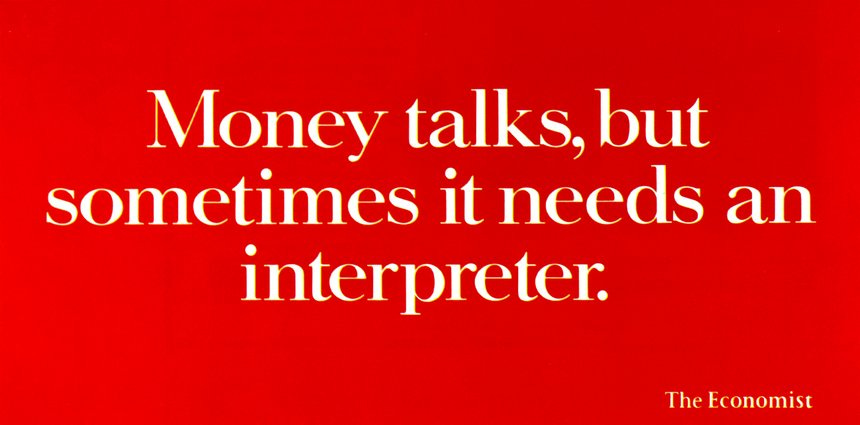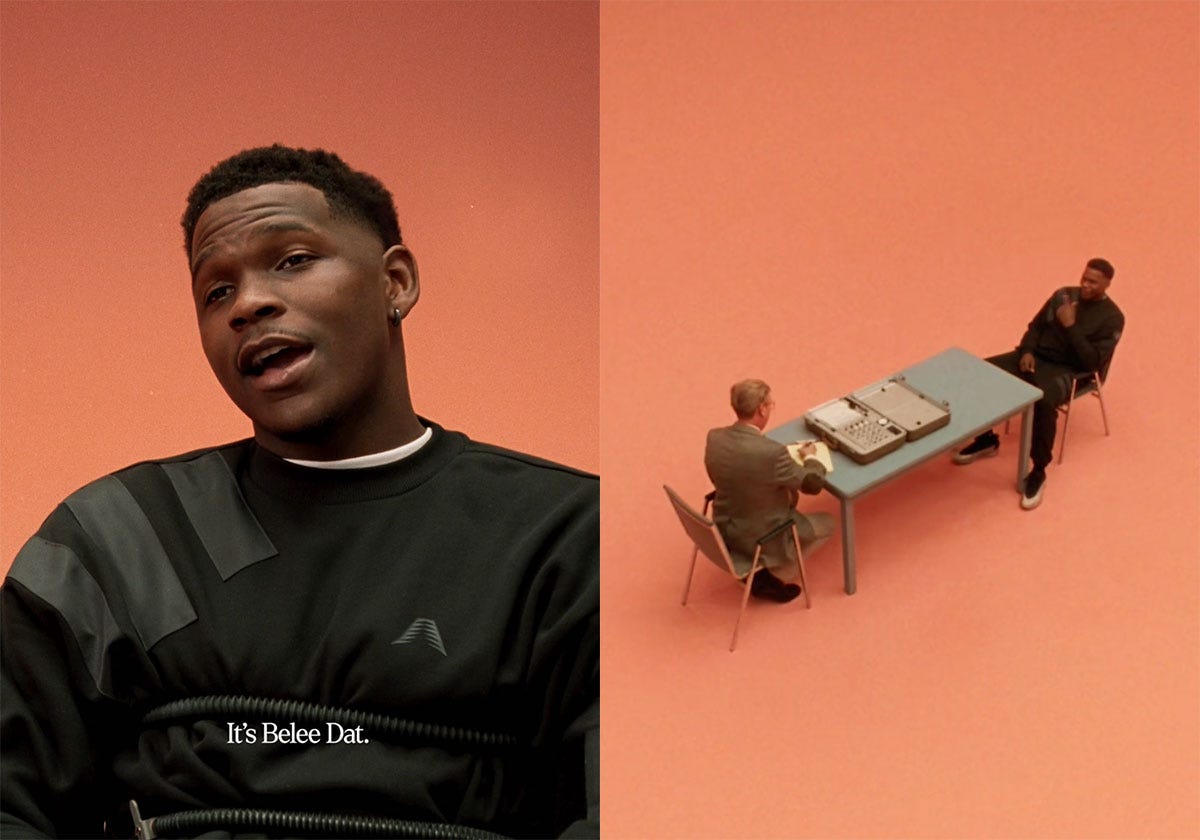Great Campaigns Start With Great Copy
How I validate my big ideas.
Today I want to talk about campaigns. I enjoy that they require a different type of creative thinking than a one-off social post. There’s a brief and messaging goals to keep in focus. Maybe there’s a new product or celebrity partner. Brand stakeholders contribute ideas and give feedback. So much feedback.
Then you release it into the world. You hope your audience reacts the way you imagined they would when you pitched the idea over Zoom five months ago. There’s the thrill of pressing post and refreshing the comments. It’s live. It’s real.
With this work, the goal is always to come up with a concept that delivers on its promise. Expectations vs reality should be two identical images. One of my favorite ways to make sure the campaign gets there? Start with copy.
The Lie Detector Test
When you brainstorm a campaign idea for a new product or partnership, it’s easy to immediately become obsessed with the tactics. What if we did this? And partnered with them? And had this person shoot it? And showed up here?
Slow down.
Take a beat.
Start by writing a thesis for your big idea.
Why does it work?
Writing a campaign thesis is like putting your campaign concept through a lie detector test. It reveals the cracks. It shows the opportunities.
Before putting anything into a formal deck or pitch, I like to write out:
The campaign thesis. This is a paragraph should explain why the idea works, who it’s for, how we want people to feel, and why it’s true.
The big idea. Force yourself to explain it in 2-3 sentences. Can you?
A handful of headlines or taglines. Maybe these never see the light of day, but they help validate that the big idea works. Plus it gets the clichés out of your system.
If I had to write the announcement caption today, what would it be? This is something to ask yourself way earlier on in the process than you would imagine. It helps you think about how you’d frame the big idea to your audience.
Pitch the idea out loud to no one. Pretend you’re explaining the big idea to a friend. Where do you get tripped up? Where do you start to not believe yourself?
In case it’s not already clear, “start with copy” doesn’t necessarily mean you must write the public-facing tagline first—although you certainly can. It means that you should validate your big idea with words.
Let’s Try This
Close your eyes. Think about one of the biggest campaign flops you’ve witnessed online. I have mine. Now try and imagine how they pitched it. Think about what the thesis might have been.
You can’t, right?
When I see a bad campaign I often think to myself, Was no one asked to simply explain this out loud?
So many bad ideas could have been tossed aside or tweaked if they had just gone through the thesis lie detector test! That’s because good campaigns are true.
Experts Agree
When I watched Rion Harmon, co-founder of Day Job, present at Adobe MAX earlier this year, he had a slide that simply said “copy then design”. I asked him to expand on that idea and he told me, “If design doesn't have an idea to articulate what even is it at that point? It becomes ornamentation. It does nothing. The idea, the copy, has to come first or you're simply designing something to look pretty. Which anyone can do, and everyone will forget.”
One of the most popular Link in Bio interviews is with Arin Delaney and Madison Palasini, the copywriting duo behind FONZIE. When I asked them about campaign copy, they told me, “We think of those big, juicy taglines as punchlines. It’s very similar to joke writing. A meandering story suddenly becomes crystal clear when you hear that final line. Same with a campaign. Once you have the perfect tagline, the campaign will reveal itself to you.”
Merit’s Approach
The brand with the most memorable campaigns this year was Merit. In an interview with newsletter PEOPLE BRANDS AND THINGS, Aila Morin, Merit’s CMO, spoke about the first stages of campaign ideation.
She said, “The marketing story always builds off of the product positioning—I usually start drafting it years before the product actually comes to life, pulling references and distilling what the thesis is. All of our teams work backwards from this concept—as CMO, I sit across our Creative, Marketing, and Product Development teams, which allows me to be involved in every step of a campaign and ensure that the thesis is kept top of mind throughout.”
Lucky for us, Merit recently used their internal-facing thesis for voiceover to announce their eye shadows. Here’s the transcript: “We’ll be the first to admit—we stopped wearing eyeshadow. The maximalism of the last decade made it so overwhelming and complicated that it fell out of our routines completely. But years after abandoning it, we asked ourselves what it would take to make an eyeshadow we’d actually finish. Because honestly, when was the last time you hit pan? Solo Shadow is the antidote to the 50-shade palettes of the 2010s. It’s a single wash of color in a soft-matte finish. Available in eight shades, it’s impossible to mess up. So you’ll reach for it every day—not just on special occasions. This is makeup you can live in.”
Robin Bouweiri, Brand Design and Social Lead at MERIT, told me in a Link in Bio interview, “As for the narrated ‘thesis’ statement, it was actually never intended to be public-facing. Our team writes one of these for all our major launches—it’s essentially our storytelling north star for a campaign, but it isn’t normally something we share. The thesis for Solo Shadow, however, did such a great job of capturing the emotion at the heart of the launch, so we decided to take a chance and use it in lieu of more traditional narration.”
“Wait…I work in social media, not copywriting”
All social media professionals should want to learn more about good copy.
As writer Russell Davies said in this article, “The great power of copywriting is that writing is thinking. Great copywriters are also great strategists. If more creatives were forced to think through the problem as rigorously as writers have to do we'd have a world of tighter, brighter communications.”
Writing Is Hard
Maybe I should have started with this, but coming up with big ideas and writing good copy is really hard! Effortless copy takes effort. One of my favorite resources for honing my copy skills is The Copy Book by D&AD. It compiles advice from some of the most famous copywriters. I check in with it every few months. Here are some of my favorite tips from the book:
Leave the office. Get out and observe. Your raw material isn’t in the office. It’s out in the streets. Go to films. See plays. And more importantly look at people. (via James Lowther)
Know your target audience. Not intellectually, but intuitively. Think like them, empathize with them, identify with them. Because at some level, the reader needs to like the writer. (via Mary Wear)
Think of what everybody does in the category of product you’re advertising and do the opposite. Why do all our car ads look the same? Why do all our washing powder ads look the same? (via James Lowther)
Think visually. Sometimes the best copy is no copy. (via David Abbott)
Product advertising explains the product to me. Brand advertising explains me to me. (via John Bevins)
Read your copy out loud to yourself. If it helps, pick up a phone and pretend you’re presenting the copy to someone on the other end. (via Adrian Holmes)
Always be collecting. Keep your radar on for anything remotely interesting. Be bothered to write it down or photograph it. Then file it away. (via Sean Doyle)
We Know Our Audience Best
I still hear from plenty of social teams that they aren’t involved in the campaign ideation process. This is a problem—especially when so many campaigns hinge on social performance.
I urge creative teams to bring their social teams into the campaign process. Let us in at the beginning. No one knows a brand’s audience better.
Final Word
Working in social, sometimes it feels like we’re taught that copy is just captions. That’s not true. Copy is emotions, stories, and truths. Those are the things that stick.
I think about this quote from my interview with FONZIE often: “Writing with ‘gravitas’ can cause your head to turn upward. You tell yourself this is important, your page is filled with this aspirational, big-wide-arms stuff. It’s a trap. Put it down and step away. Start with something true, e.g., Moms aren’t feeling appreciated. They don’t know how to make time for themselves anymore. They just want to be left alone. Whatever it is, let the truth resonate, then move in the direction of what you want to see in the world. Always look straight ahead.”
Starting with copy helps you avoid the traps. It distills the big idea. It puts everything into focus. It makes you feel something before it exists. It allows you to look straight ahead.
You can support free essays like this one with a paid Link in Bio subscription!
It’s likely an educational expense at your company—here’s a template for you to use when asking your manager. I personally think the Discord is worth the subscription alone.
Lastly, there are some great new jobs on the Link in Bio Job Board!









Writing is thinking. Period. Even if you feel a rush of brilliance, write it down to pressure test it. Does it hold up? Does it sound good out loud? The advice in here is killer. For all the best brand writing and copywriting resources, check out the subtext.online!
I work in-house as a copywriter at a large retail company and one of my favorite things to do is go shopping. I learn a lot as an actual customer about how effective our branding, strategy and copy is. It's also a great excuse to go shopping. Obviously not always possible, but if you can put yourself in your customer's shoes as that same kind of customer, you can see how well, or not, you're doing your job.